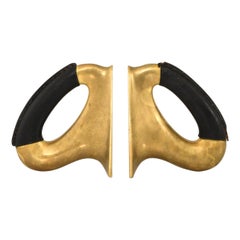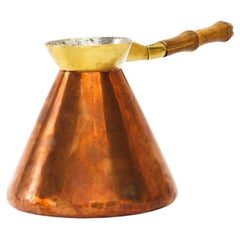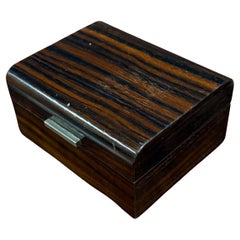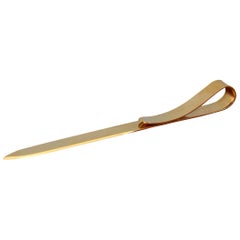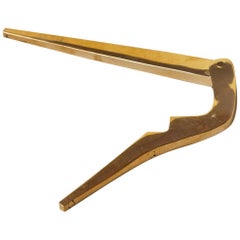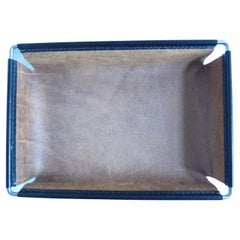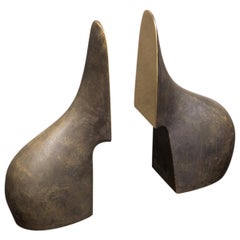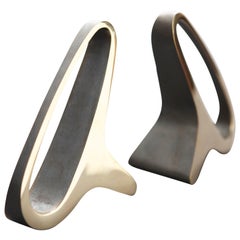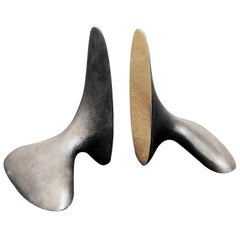Carl Aubock Vintage
to
148
2,759
858
3,656
3,111
1,688
414
107
101
59
55
16
2
2,495
57
53
27
5
Sort By
Carl Auböck Bookends
By Werkstätte Carl Auböck
Located in Limhamn, Skåne län
Rare pair of bookends designed by Carl Auböck.
Category
1950s European Scandinavian Modern Carl Aubock Vintage
Materials
Brass
Coffee pot by Carl Auböck 1950s for Werkstätte Carl Auböck. ( signed )
By Werkstätte Carl Auböck
Located in Wien, AT
Coffee pot by Carl Auböck 1950s for Werkstätte Carl Auböck. ( signed )
Original condition
Category
1950s Austrian Mid-Century Modern Carl Aubock Vintage
Materials
Brass, Copper
$655
H 5.12 in W 5.12 in D 9.45 in
rare carl auböck box
By Werkstätte Carl Auböck
Located in Munich, DE
rare piece from the carl auböck workshop.
Category
1950s Austrian Mid-Century Modern Carl Aubock Vintage
Materials
Metal
Carl Auböck Paperknife #7209
By Werkstätte Carl Auböck
Located in Berlin, DE
Brass paperknife #7209 by Carl Auböck.
Category
Mid-20th Century Austrian Mid-Century Modern Carl Aubock Vintage
Materials
Brass
Carl Auböck #4243 Nutcracker
By Werkstätte Carl Auböck
Located in Berlin, DE
Nutcracker #4243 by Carl Auböck in solid brass.
Category
20th Century Austrian Mid-Century Modern Carl Aubock Vintage
Materials
Brass
Carl Auböck Leather Tray
By Werkstätte Carl Auböck
Located in Vienna, AT
Carl Auböck tray in leather and brass, Austria. Super beautiful.
Category
1950s Austrian Carl Aubock Vintage
Materials
Brass, Nickel
Carl Auböck Bookends # 3652
By Werkstätte Carl Auböck
Located in Berlin, DE
Classic pair of Carl Auböck bookends in polished brass.
Category
Mid-20th Century Austrian Mid-Century Modern Carl Aubock Vintage
Materials
Brass
Carl Auböck Bookends #3848
By Werkstätte Carl Auböck
Located in Berlin, DE
Classis pair of Carl Auböck bookend in a patina and polish brass mix.
Category
Mid-20th Century Mid-Century Modern Carl Aubock Vintage
Materials
Brass
Carl Auböck Bookends #3653
By Werkstätte Carl Auböck
Located in Berlin, DE
Classic pair of Carl Auböck bookends in a patina and polish brass mix.
Category
1960s Austrian Mid-Century Modern Carl Aubock Vintage
Materials
Brass
Carl Aubock Rare Barware Decanter
By Werkstätte Carl Auböck
Located in Chicago, IL
Carl Auböck Rare Barewear Decanter, cork top, mahogany wood with leather embossed clock face image
Category
1950s Austrian Mid-Century Modern Carl Aubock Vintage
Materials
Glass, Mahogany, Cork
Carl Auböck Coffee table
By Werkstätte Carl Auböck
Located in Hudson, NY
Werkstätte Carl Auböck, Vienna, Austria, 1950s. Table number 11. Untouched and with 70 years of
Category
Mid-20th Century European Bauhaus Carl Aubock Vintage
Materials
Brass
Carl Aubock bronze vide poche
By Werkstätte Carl Auböck
Located in grand Lancy, CH
Carl Aubock vide poche
Category
1960s Austrian Carl Aubock Vintage
Materials
Bronze
Carl Auböck Candlestick, Austria, 1960s
By Werkstätte Carl Auböck
Located in Berlin, DE
Carl Auböck candlestick, Austria 1960s.
Category
1960s Austrian Mid-Century Modern Carl Aubock Vintage
Materials
Brass
Carl Auböck Brush, Austria 1960s
By Werkstätte Carl Auböck
Located in Berlin, DE
Carl Auböck Brush, Austria 1960s.
Category
1960s Austrian Mid-Century Modern Carl Aubock Vintage
Materials
Wood
Carl Auböck Knife, Austria 1960s
By Werkstätte Carl Auböck
Located in Berlin, DE
Carl Auböck knife, Austria 1960s.
Category
1960s Austrian Mid-Century Modern Carl Aubock Vintage
Materials
Steel
Carl Auböck Bell, Austria 1960s
By Werkstätte Carl Auböck
Located in Berlin, DE
Carl Auböck bell, Austria 1960s.
Category
1960s Austrian Mid-Century Modern Carl Aubock Vintage
Materials
Brass
Carl Auböck Lighter, Austria 1960s
By Werkstätte Carl Auböck
Located in Berlin, DE
Carl Auböck Lighter, Austria 1960s.
Category
1960s Austrian Mid-Century Modern Carl Aubock Vintage
Materials
Brass
Carl Auböck Humidor, Austria 1960s
By Werkstätte Carl Auböck
Located in Berlin, DE
Carl Auböck Humidor, Austria 1960s.
Category
1960s Austrian Mid-Century Modern Carl Aubock Vintage
Materials
Brass, Aluminum
Carl Auböck Lighter, Austria 1960s
By Werkstätte Carl Auböck
Located in Berlin, DE
Carl Auböck Lighter, Austria 1960s.
Category
1960s Austrian Mid-Century Modern Carl Aubock Vintage
Materials
Brass
Carl Auböck Nutcracker, Austria, 1960s
By Werkstätte Carl Auböck
Located in Berlin, DE
Carl Auböck nutcracker, Austria 1960s.
Category
1960s Austrian Mid-Century Modern Carl Aubock Vintage
Materials
Brass
Carl Auböck Bowl, Austria 1960s
By Werkstätte Carl Auböck
Located in Berlin, DE
Carl Auböck Bowl, Austria 1960s.
Category
1960s Austrian Mid-Century Modern Carl Aubock Vintage
Materials
Brass
Carl Auböck Bowl, Austria 1960s
By Werkstätte Carl Auböck
Located in Berlin, DE
Carl Auböck Bowl, Austria 1960s.
Category
1960s Austrian Mid-Century Modern Carl Aubock Vintage
Materials
Brass
Carl Auböck Bowl, Austria 1960s
By Werkstätte Carl Auböck
Located in Berlin, DE
Carl Auböck Bowl, Austria 1960s.
Category
1960s Austrian Mid-Century Modern Carl Aubock Vintage
Materials
Brass
Carl Auböck Bowl, Austria 1960s
By Werkstätte Carl Auböck
Located in Berlin, DE
Carl Auböck Bowl, Austria 1960s.
Category
1960s Austrian Mid-Century Modern Carl Aubock Vintage
Materials
Brass
Carl Auböck Bowl, Austria 1960s
By Werkstätte Carl Auböck
Located in Berlin, DE
Carl Auböck Bowl, Austria 1960s.
Category
1960s Austrian Mid-Century Modern Carl Aubock Vintage
Materials
Brass
Carl Auböck Bowl, Austria 1960s
By Werkstätte Carl Auböck
Located in Berlin, DE
Carl Auböck Bowl, Austria 1960s.
Category
1960s Austrian Mid-Century Modern Carl Aubock Vintage
Materials
Brass
Carl Auböck Bowl, Austria 1960s
By Werkstätte Carl Auböck
Located in Berlin, DE
Carl Auböck Bowl, Austria 1960s.
Category
1960s Austrian Mid-Century Modern Carl Aubock Vintage
Materials
Brass
Carl Auböck Ashtray, Austria 1960s
By Werkstätte Carl Auböck
Located in Berlin, DE
Carl Auböck Ashtray, Austria 1960s.
Category
1960s Austrian Mid-Century Modern Carl Aubock Vintage
Materials
Brass
Carl Auböck Ashtray, Austria, 1960s
By Werkstätte Carl Auböck
Located in Berlin, DE
Carl Auböck ashtray, Austria, 1960s.
Category
1960s Austrian Mid-Century Modern Carl Aubock Vintage
Materials
Brass
Carl Auböck Ashtray, Austria 1960s
By Werkstätte Carl Auböck
Located in Berlin, DE
Carl Auböck Ashtray, Austria 1960s.
Category
1960s Austrian Mid-Century Modern Carl Aubock Vintage
Materials
Brass
Carl Auböck Ashtray, Austria 1960s
By Werkstätte Carl Auböck
Located in Berlin, DE
Carl Auböck Ashtray, Austria 1960s.
Category
1960s Austrian Mid-Century Modern Carl Aubock Vintage
Materials
Brass
Carl Auböck Bowl, Austria 1960s
By Werkstätte Carl Auböck
Located in Berlin, DE
Carl Auböck Bowl, Austria 1960s.
Category
1960s Austrian Mid-Century Modern Carl Aubock Vintage
Materials
Brass
Cigarette Box by Carl Auböck
By Werkstätte Carl Auböck
Located in Banská Štiavnica, SK
Brass and wooden cigarette box, designed by Carl Auböck, shows a beautiful guilloche top surface
Category
1950s Austrian Mid-Century Modern Carl Aubock Vintage
Materials
Brass
small carl auböck magazine rack
By Werkstätte Carl Auböck
Located in Munich, DE
wonderful, small magazine rack by carl auböck.
Category
1950s Austrian Mid-Century Modern Carl Aubock Vintage
Materials
Brass
Carl Auböck for Werkstätte Carl Auböck 'Tree' Coffee Table with Walnut Slab
By Werkstätte Carl Auböck
Located in Waalwijk, NL
Carl Auböck for Werkstätte Carl Auböck, 'Tree' coffee table, walnut, lacquered brass, rubber
Category
1950s Austrian Mid-Century Modern Carl Aubock Vintage
Materials
Metal, Brass
$13,800
H 18.51 in W 47.25 in D 16.93 in
Carl Auböck Pipe Paperweight, Brass, Signed
By Werkstätte Carl Auböck
Located in New York, NY
Carl Auböck Pipe Paperweight, Brass, Signed. Small scale meticulously detailed brass pipe
Category
1950s Austrian Mid-Century Modern Carl Aubock Vintage
Materials
Brass
Carl Auböck Knife, Austria 1960s
By Werkstätte Carl Auböck
Located in Berlin, DE
Carl Auböck Knife made of steel and horn, Austria 1960s.
Category
1960s Austrian Mid-Century Modern Carl Aubock Vintage
Materials
Steel
Carl Auböck #4959 Floor Mirror
By Werkstätte Carl Auböck
Located in Berlin, DE
Floor mirror #4959 by Carl Auböck in brass and walnut.
Category
Mid-20th Century Austrian Mid-Century Modern Carl Aubock Vintage
Materials
Brass
Carl Auböck Brush, Austria 1960s
By Werkstätte Carl Auböck
Located in Berlin, DE
Carl Auböck Letter brush made of horn and horsehair, Austria 1960s.
Category
1960s Austrian Mid-Century Modern Carl Aubock Vintage
Materials
Horn
Carl Auböck Nutcracker in Brass for Werkstätte Carl Auböck, Austria 1950s
By Werkstätte Carl Auböck
Located in Esbjerg, DK
Carl Auböck and made at his own studio during the 1950s. It has been polished and cleaned over the
Category
1950s Austrian Mid-Century Modern Carl Aubock Vintage
Materials
Brass
Bookends by Carl Auböck III
By Werkstätte Carl Auböck
Located in San Diego, CA
Rare pair of bookends by Carl Auböck III.
Nickel plated steel. 1970s.
Category
1970s Austrian Mid-Century Modern Carl Aubock Vintage
Materials
Steel
Carl Auböck Ashtray "Marked by Auböck"
By Werkstätte Carl Auböck
Located in Wien, AT
Carl Auböck ashtray "Marked by Auböck"
Original condition.
Category
1950s Austrian Mid-Century Modern Carl Aubock Vintage
Materials
Brass
Carl Auböck Pitcher, Austria, 1960s
By Werkstätte Carl Auböck
Located in Berlin, DE
Carl Auböck pitcher, Austria 1960s. The width of the item including the handle is 18 cm.
Category
1960s Austrian Mid-Century Modern Carl Aubock Vintage
Materials
Leather, Glass
Carl Auböck III Fondue Set
By Werkstätte Carl Auböck
Located in Chicago, IL
Carl Auböck III Fondue set, by Riess: Enameled steel, stainless steel,
Austria, circa 1980
Signed
Category
1980s Mid-Century Modern Carl Aubock Vintage
Materials
Metal
Carl Auböck Magnifier, Austria 1960s
By Werkstätte Carl Auböck
Located in Berlin, DE
Carl Auböck bowl, Austria 1960s. The measurements given apply to the magnifier. The cover measures
Category
1960s Austrian Mid-Century Modern Carl Aubock Vintage
Materials
Horn, Leather, Glass
Mid-Century Carl Auböck Bronze Nutcracker - 1950s
By Werkstätte Carl Auböck
Located in Linkebeek, BE
Mid-Century Carl Auböck Bronze Nutcracker - 1950s
Vintage - Decoration - Home Decor
Measures
Category
20th Century Austrian Mid-Century Modern Carl Aubock Vintage
Materials
Bronze
Carl Auböck Brush Pen Holder
By Werkstätte Carl Auböck
Located in London, GB
A wonderful little pen holder by Carl Auböck. Handmade in Vienna in the 1950s. A beautiful delicate
Category
1950s Austrian Modern Carl Aubock Vintage
Materials
Walnut
20th Century Carl Auböck Nutwood Humidor
By Werkstätte Carl Auböck
Located in Vienna, AT
Carl Auböck Humidor, Austria 1950s
Category
20th Century European Carl Aubock Vintage
Materials
Nutwood
Carl Auböck Wooden Tray, Austria, 1960s
By Werkstätte Carl Auböck
Located in Berlin, DE
Carl Auböck tray, Austria, 1960s.
Category
1960s Austrian Mid-Century Modern Carl Aubock Vintage
Materials
Wood
Carl Auböck Bottle Holder, Austria 1960s
By Werkstätte Carl Auböck
Located in Berlin, DE
Carl Auböck bottle holder, Austria 1960s.
Category
1960s Austrian Mid-Century Modern Carl Aubock Vintage
Materials
Brass
Carl Auböck Dust Brush, Austria 1960s
By Werkstätte Carl Auböck
Located in Berlin, DE
Carl Auböck Dust Brush, Austria 1960s.
Category
1960s Austrian Mid-Century Modern Carl Aubock Vintage
Materials
Wood
Carl Auböck Bottle Opener, Austria 1960s
By Werkstätte Carl Auböck
Located in Berlin, DE
Carl Auböck bottle opener, Austria 1960s.
Category
1960s Austrian Mid-Century Modern Carl Aubock Vintage
Materials
Brass
Carl Auböck Horn Penrest, Austria 1960s
By Werkstätte Carl Auböck
Located in Berlin, DE
Carl Auböck Horn Penrest, Austria 1960s.
Category
1960s Austrian Mid-Century Modern Carl Aubock Vintage
Materials
Horn
Carl Auböck Pen Holder, Austria, 1960s
By Werkstätte Carl Auböck
Located in Berlin, DE
Carl Auböck pen holder, Austria, 1960s.
Category
1960s Austrian Mid-Century Modern Carl Aubock Vintage
Materials
Horn
Carl Auböck Pipe Holder, Austria 1960s
By Werkstätte Carl Auböck
Located in Berlin, DE
Carl Auböck Pipe Holder, Austria 1960s.
Category
1960s Austrian Mid-Century Modern Carl Aubock Vintage
Materials
Brass
Carl Auböck Bottle Opener, Austria 1960s
By Werkstätte Carl Auböck
Located in Berlin, DE
Carl Auböck Bottle Opener, Austria 1960s.
Category
1960s Austrian Mid-Century Modern Carl Aubock Vintage
Materials
Brass
Carl Auböck Bottle Opener, Austria, 1960s
By Werkstätte Carl Auböck
Located in Berlin, DE
Carl Auböck bottle opener, Austria, 1960s.
Category
1960s Austrian Mid-Century Modern Carl Aubock Vintage
Materials
Brass
Carl Auböck Cork Screw, Austria, 1960s
By Werkstätte Carl Auböck
Located in Berlin, DE
Carl Auböck cork screw, Austria 1960s.
Category
1960s Austrian Mid-Century Modern Carl Aubock Vintage
Materials
Brass, Steel
- 1
- ...
Get Updated with New Arrivals
Save "Carl Aubock Vintage", and we’ll notify you when there are new listings in this category.
Carl Aubock Vintage For Sale on 1stDibs
With a vast inventory of beautiful furniture at 1stDibs, we’ve got just the carl aubock vintage you’re looking for. Frequently made of metal, brass and animal skin, every carl aubock vintage was constructed with great care. There are many kinds of the carl aubock vintage you’re looking for, from those produced as long ago as the 20th Century to those made as recently as the 20th Century. When you’re browsing for the right carl aubock vintage, those designed in Mid-Century Modern, Modern and Scandinavian Modern styles are of considerable interest. Carl Auböck, Werkstätte Carl Auböck and Hertha Baller each produced at least one beautiful carl aubock vintage that is worth considering.
How Much is a Carl Aubock Vintage?
The average selling price for a carl aubock vintage at 1stDibs is $1,227, while they’re typically $69 on the low end and $20,000 for the highest priced.
More Ways To Browse
Vintage Pierre Cardin Belt
Aorta Vase
Carl Aubock Cigarette Box
Horn Table Lighter
Aubock Love
Aubock Neptune
Carl Aubock Clock
Carl Aubock Tea Set
Dior Humidor
Antique Mail Organizer
Antique Royal Typewriter
Blickensderfer Typewriter
Burroughs Adding Machine
Carl Aubock Magnifying
Copenhagen Tumbler Pot
Doulton Gaffers
Fornasetti Bell
Gargoyle Mobiloil Gas Pump Globe
